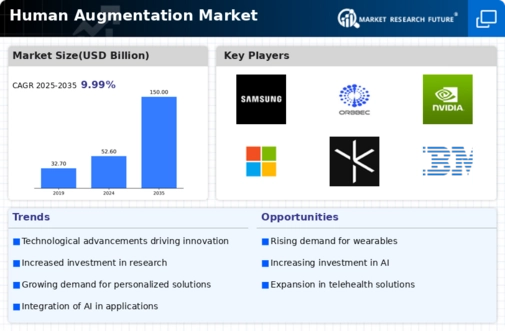Top Industry Leaders in the Human Augmentation Market

Competitive Landscape of the Human Augmentation Market:
The human augmentation market, encompassing technologies enhancing human capabilities, is experiencing explosive growth, driven by advancements in medical technology, wearables, and burgeoning VR/AR landscapes. This dynamic environment fosters fierce competition, with established players and new entrants vying for market share.
Key Players:
- BrainGate Company
- B-Temia
- Ekso Bionics Holdings
- Raytheon Company
- Samsung Electronics Co Ltd
- Cyberdyne
- Bionik Laboratories Corporation
- Panasonic Corporation
- Toyota Motor Corporation
- Parker Hannifin
Strategies Adopted:
- Mergers and Acquisitions: Large companies acquire promising startups to bolster their technological prowess and expand their product portfolio. Examples include Google's acquisition of Verily Life Sciences and Fitbit, and Facebook's acquisition of Oculus VR.
- Partnerships and Collaborations: Companies collaborate to leverage each other's strengths and expertise. Examples include Apple partnering with Nike for fitness tracking and Samsung collaborating with Microsoft for HoloLens development.
- Vertical Integration: Companies strive to control the entire value chain, from research and development to manufacturing and distribution. This ensures greater control over product quality, pricing, and customer experience.
- Product Innovation: Continuous research and development are crucial to stay ahead of the curve. Companies invest heavily in cutting-edge technologies like brain-computer interfaces, neural implants, and advanced prosthetics.
- Market Expansion: Companies aggressively expand into new geographical markets to tap into untapped potential. This involves tailoring products and marketing strategies to local preferences and regulations.
Factors for Market Share Analysis:
- Product Portfolio: Breadth and depth of product offerings cater to diverse needs and applications.
- R&D Investment: Demonstrates commitment to innovation and future growth potential.
- Distribution Network: Extensive and efficient distribution channels ensure wider product reach and market penetration.
- Brand Recognition: Established brands enjoy a competitive advantage in terms of trust and customer loyalty.
- Financial Performance: Strong financial performance reflects the company's ability to sustain its operations and invest in future growth.
New and Emerging Companies:
Numerous startups are entering the human augmentation market with disruptive technologies and innovative business models. Examples include companies like CTRL-Labs developing wristband-based neurointerfaces, and Kernel developing non-invasive brain-computer interfaces for communication and control.
Current Company Investment Trends:
- Increased investment in AI and machine learning: To personalize and optimize human augmentation solutions.
- Focus on miniaturization and wearability: For greater user comfort and convenience.
- Exploration of non-invasive technologies: To minimize risks associated with surgery and implants.
- Development of closed-loop systems: For automatic and seamless interaction between humans and augmentation devices.
- Emphasis on ethical considerations: To address concerns about privacy, data security, and potential misuse of technology.
Latest Company Updates:
Elon Musk's brain-implant corporation Neuralink achieved a significant milestone in 2023 when the FDA approved its first-in-human clinical study. This was despite the company being investigated by the US government for its treatment of animal research.
At its yearly World Wide Developers Conference (WWDC) in 2023, Apple unveiled the VR headgear along with updates on several of its current hardware and software releases. A wearable headset called the Apple Vision Pro can be used for a variety of activities, such as gaming, movies, and meditation in addition to work meetings and meditation. According to Apple, it will launch in early 2024.
Three new human augmentation solution prototypes are being developed in Japan by Kyocera Corporation in 2022: an auditory augmentation device, a physical avatar, and a walk sensing and coaching system. Based on the idea Mai developed by Kyocera's Future Design Laboratory, all three solutions have been developed. By enhancing and enhancing human capacities, human augmentation makes use of cutting-edge artificial intelligence (AI) and other technology to enable new experiences and capabilities.









